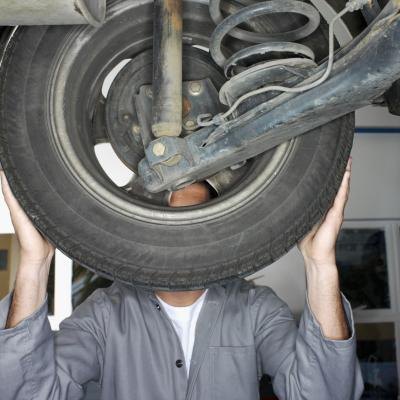Wednesday, March 19, 2014
Can You Run Cupped Tires on a Vehicle Until They Smooth Out

A good diagnostician is something of a Car Whisperer, one who can pick up on the tiniest of clues to intuit both the cause of a problem and the avenue to its solution. Tire cupping isnt the most common wear pattern out there, but it is one of the most serious and telling in terms of diagnosing the chassis condition.
Cupping
In terms of tire wear patterns, "cupping" ers to a series of regular dips appearing in the outer edge of a tires tread. Also called "scalloping," these dips look as though someones taken shallow scoops out of the rubber with the worlds most sinister ice cream scooper. This sort of cupping shouldnt be confused with the cupping that often occurs on large drag tires. In this context, cupping happens when the tires inflation pressure is too low and the center of the tire curves upward or "cups" at high speed.
Cupping Causes
Cupping is a sign of rapid tire bounce or side-to-side oscillation. Theres no one single cause behind such bouncing or oscillations; any component that connects the wheel to the car is suspect. Worn shock absorbers will fail to control wheel movement, allowing the tires to bounce and cup the tread. Suspension bushings and ball joints are secondary suspects, followed by wheel bearings and steering end-links. The last two, however, should exhibit noticeable symptoms -- vibration through the steering wheel and chassis -- well before cupping becomes an issue.
Argument 1 -- Driving on Cupped Tires
Some contend that cupping isnt necessarily a death sentence for tires, provided that the lowest point in the scallops dont extend past the tires lowest safe wear zone. After youve fixed whats causing the cupping, the high points in the scallops will wear far more quickly than the low points, which should smooth them out over time. Rotating the tires may help to speed the smoothing, since doing so will at least change the frequency of oscillation acting upon that tire.
Argument 2 -- Not Driving on Cupped Tires
While it is true that fixing the problem and driving on cupped tires may eventually smooth them out, the fact is that the low points in the scallops will continue to wear just like the high points. Granted, theyll wear more slowly, but even with the best-case scenario, youre looking at a tire with a serious -- if smooth -- bald strip around the edge. From this perspective, any cupping at all is the death knell for your tire and a sign that it needs replacement ASAP.
Conclusion
Provided that youve replaced the worn shocks, bushings or relevant suspension component, driving on a cupped tire will eventually smooth it out to some extent. But thats like saying that sooner or later the wind will eventually erode mountains. True, it will, but itll also erode the valleys between the mountains and create low-lying dips in the landscape. Its a game of time and specific conditions, and one youre probably going to lose. Considering the likelihood and consequences of tire failure after cupping, youre best off replacing the cupped tire sooner rather than later.
No comments:
Post a Comment